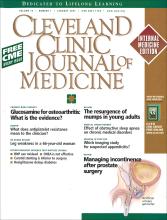Index by author
Atiemo, Humphrey O.
- You have accessEvaluating and managing urinary incontinence after prostatectomy: Beyond pads and diapersHumphrey O. Atiemo, MD, Louis Moy, MD, Sandip Vasavada, MD and Raymond Rackley, MDCleveland Clinic Journal of Medicine January 2007, 74 (1) 57-63;
Men who become persistently incontinent after undergoing prostatectomy have a variety of options for regaining control, from behavioral changes to surgery.
Bellini, William J.
- You have accessMumps surveillance and prevention: Putting mumps back on our radar screenMoe H. Kyaw, PhD, William J. Bellini, PhD and Gustavo H. Dayan, MDCleveland Clinic Journal of Medicine January 2007, 74 (1) 13-15;
After the mumps vaccine was introduced, the incidence of mumps fell by 99%. Many of the current generation of physicians have never seen this disease.
Collop, Nancy
- You have accessThe effect of obstructive sleep apnea on chronic medical disordersNancy Collop, MDCleveland Clinic Journal of Medicine January 2007, 74 (1) 72-78;
Evidence is mounting that obstructive sleep apnea causes or contributes to many chronic medical diseases, and that treatment with continuous positive airway pressure often improves the concomitant diseases.
Dayan, Gustavo H.
- You have accessMumps surveillance and prevention: Putting mumps back on our radar screenMoe H. Kyaw, PhD, William J. Bellini, PhD and Gustavo H. Dayan, MDCleveland Clinic Journal of Medicine January 2007, 74 (1) 13-15;
After the mumps vaccine was introduced, the incidence of mumps fell by 99%. Many of the current generation of physicians have never seen this disease.
Einstein, David M.
- You have accessWhich imaging test for right lower quadrant pain?Darlene M. Holden, MD and David M. Einstein, MDCleveland Clinic Journal of Medicine January 2007, 74 (1) 37-40;
A 36-year-old woman presents to the emergency department with abdominal pain and intermittent nausea. You suspect that she has acute appendicitis. Which imaging test should you order to further evaluate this patient?
- You have accessWhich imaging test for right lower quadrant pain?Darlene M. Holden, MD and David M. Einstein, MDCleveland Clinic Journal of Medicine January 2007, 74 (1) 37-40;
A 36-year-old woman presents to the emergency department with abdominal pain and intermittent nausea. You suspect that she has acute appendicitis. Which imaging test should you order to further evaluate this patient?
Factora, Ronan M.
- You have accessIn reply: Primary progressive aphasiaRonan M. Factora, MDCleveland Clinic Journal of Medicine January 2007, 74 (1) 9;
Falluji, Nezar
- You have accessVariable response to antiplatelet therapy: What does it mean to clinicians?Nezar Falluji, MD, MPH and Steven R. Steinhubl, MDCleveland Clinic Journal of Medicine January 2007, 74 (1) 49-55;
Ex vivo tests show that platelet function and response to antiplatelet therapy vary markedly from person to person. But just how clinically significant are these measurements?
Herts, Brian R.
- You have accessWhich imaging test for right lower quadrant pain?Darlene M. Holden, MD and David M. Einstein, MDCleveland Clinic Journal of Medicine January 2007, 74 (1) 37-40;
A 36-year-old woman presents to the emergency department with abdominal pain and intermittent nausea. You suspect that she has acute appendicitis. Which imaging test should you order to further evaluate this patient?
Holden, Darlene M.
- You have accessWhich imaging test for right lower quadrant pain?Darlene M. Holden, MD and David M. Einstein, MDCleveland Clinic Journal of Medicine January 2007, 74 (1) 37-40;
A 36-year-old woman presents to the emergency department with abdominal pain and intermittent nausea. You suspect that she has acute appendicitis. Which imaging test should you order to further evaluate this patient?
Kyaw, Moe H.
- You have accessMumps surveillance and prevention: Putting mumps back on our radar screenMoe H. Kyaw, PhD, William J. Bellini, PhD and Gustavo H. Dayan, MDCleveland Clinic Journal of Medicine January 2007, 74 (1) 13-15;
After the mumps vaccine was introduced, the incidence of mumps fell by 99%. Many of the current generation of physicians have never seen this disease.




